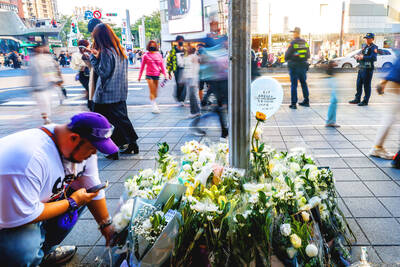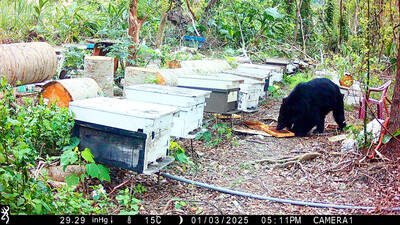There was a flurry of activity in Washington this week surrounding Taiwan’s submarine program — but little indication of much real progress.
Chief of US Naval Operations Admiral Jonathan Greenert confirmed that he had talked with colleagues in Taipei about the program, a Taiwanese delegation was on Capitol Hill lobbying for submarine help, and House of Representatives Committee on Foreign Affairs Chairman Ed Royce said in an interview that the US supported Taiwan’s efforts to build its own submarines.
However, sources close to US President Barack Obama’s administration and the Pentagon said there were no new moves afoot for the US to help Taiwan buy the much-needed diesel submarines or for technology transfers essential to domestic production.
“I have noted the activity surrounding Taiwan’s domestic submarine program, but do not infer that heralds progress behind the scenes,” US-Taiwan Business Council president Rupert Hammond-Chambers said.
“While the Obama administration does have several defense initiatives up and running with Taiwan, it does not appear to have any interest in defense modernization programs... That includes the submarine program and the possibility of a follow-on fighter sale,” he told the Taipei Times in an e-mail.
Hammond-Chambers said that while support from the US Congress was useful, it could not meaningfully impact US engagement on Taiwan’s submarine program.
“That can only start with the Obama administration making a policy-level decision to support the program,” he said.
Hammond-Chambers said there was “zero indication” that the White House had any intention to support Taiwan’s request for submarine help.
“They are committed to US-China mil-to-mil cooperation, and arms sales to Taiwan are linked by the Chinese and the Obama administration to the continuation of that process,” Hammond-Chambers said.
Other sources with direct links to the White House and the Pentagon, who insisted on anonymity because they were not authorized to speak on the subject, said they were aware of no new developments on Taiwan’s desire to acquire submarines.
Nevertheless, Washington-based military experts continued to support Taiwan’s need for submarines.
“There is little time to lose,” International Assessment and Strategy Center senior fellow in Asian military affairs Rick Fisher told the Taipei Times.
He said the Chinese navy was intently focused on building anti-submarine forces, including new corvettes and frigates equipped with towed active-passive sonar arrays “most useful for the sea conditions around Taiwan.”
A new Shaanxi Y-9 long-range anti-submarine warfare patrol aircraft was also being tested.
Still, finding and defeating modern very quiet conventional submarines remained one of the most difficult missions for any navy, Fisher said.
“A much larger Taiwanese submarine force will deter war on the Taiwan Strait... Washington’s failure to properly mobilize a policy focus on helping Taiwan to successfully obtain new submarines is just one of many expectations of American leadership in Asia which have fallen short in the last decade,” he said.
He said that Taiwan’s need for new submarines had been “glaringly obvious” for 20 years and successive Taiwanese governments had expended great effort toward obtaining them.
Meanwhile, US news organizations reported this week that China’s submarine fleet was projected to reach 78 vessels by 2020, the same as the US.
By way of response to the Chinese expansion, Vietnam has bought six submarines from Russia, Japan is replacing its entire submarine fleet, South Korea is adding larger attack-submarines and India plans to build six new submarines.
Stockholm Institute senior researcher Siemon Wezeman has been quoted as saying: “ Submarines are seen as a potential for an underdog to cope with a large adversary. They can move silently and deny aerial or maritime control.”

SHIPS, TRAINS AND AUTOMOBILES: The ministry has announced changes to varied transportation industries taking effect soon, with a number of effects for passengers Beginning next month, the post office is canceling signature upon delivery and written inquiry services for international registered small packets in accordance with the new policy of the Universal Postal Union, the Ministry of Transportation and Communications said yesterday. The new policy does not apply to packets that are to be delivered to China, the ministry said. Senders of international registered small packets would receive a NT$10 rebate on postage if the packets are sent from Jan. 1 to March 31, it added. The ministry said that three other policies are also scheduled to take effect next month. International cruise ship operators

HORROR STORIES: One victim recounted not realizing they had been stabbed and seeing people bleeding, while another recalled breaking down in tears after fleeing A man on Friday died after he tried to fight the knife-wielding suspect who went on a stabbing spree near two of Taipei’s busiest metro stations, Taipei Mayor Chiang Wan-an (蔣萬安) said. The 57-year-old man, identified by his family name, Yu (余), encountered the suspect at Exit M7 of Taipei Main Station and immediately tried to stop him, but was fatally wounded and later died, Chiang said, calling the incident “heartbreaking.” Yu’s family would receive at least NT$5 million (US$158,584) in compensation through the Taipei Rapid Transit Corp’s (TRTC) insurance coverage, he said after convening an emergency security response meeting yesterday morning. National

PLANNED: The suspect visited the crime scene before the killings, seeking information on how to access the roof, and had extensively researched a 2014 stabbing incident The suspect in a stabbing attack that killed three people and injured 11 in Taipei on Friday had planned the assault and set fires at other locations earlier in the day, law enforcement officials said yesterday. National Police Agency (NPA) Director-General Chang Jung-hsin (張榮興) said the suspect, a 27-year-old man named Chang Wen (張文), began the attacks at 3:40pm, first setting off smoke bombs on a road, damaging cars and motorbikes. Earlier, Chang Wen set fire to a rental room where he was staying on Gongyuan Road in Zhongzheng District (中正), Chang Jung-hsin said. The suspect later threw smoke grenades near two exits

The Forestry and Nature Conservation Agency yesterday launched a gift box to market honey “certified by a Formosan black bear” in appreciation of a beekeeper’s amicable interaction with a honey-thieving bear. Beekeeper Chih Ming-chen (池明鎮) in January inspected his bee farm in Hualien County’s Jhuosi Township (卓溪) and found that more than 20 beehives had been destroyed and many hives were eaten, with bear droppings and paw prints near the destroyed hives, the agency said. Chih returned to the farm to move the remaining beehives away that evening when he encountered a Formosan black bear only 20m away, the agency said. The bear